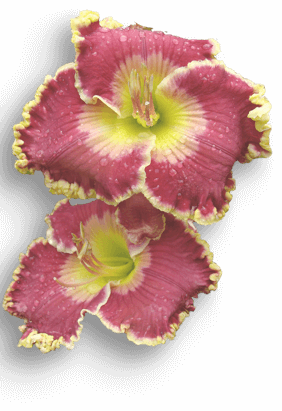A term used to describe three-dimensional structural features involving or emanating from the throat, midrib or elsewhere on the petal surfaces. Sculpted forms belong to one of three different groups: Pleated, Cristate and Relief.
Pleated:
Petals that have a deep longitudinal crease on each side of the midrib. These creases cause folding of the petal upon itself creating a raised platform extending from the top of the perianth tube and ending between the throat and the petal tip.
- Photo by Michael Brown, used with permission. Cultivar: ANASTASIA (Salter, 1995)
- Photo by Curt Hanson, used with permission. Cultivar: ‘Fad Gadget’ (Hanson-C. 2007)
- Photo by Curt Hanson, used with permission. Cultivar: ‘Mother Upduff’ (Curt Hanson 2008)
Cristate:
A term that refers to daylily flowers with appendages of extra tissue growing from the midrib or elsewhere on the surface of the petals. Cristation can occur on single and double daylilies, but a cristate single daylily is not classified as a double.
- Photo by Charmaine Rich, used with permission. Cultivar: ‘Sigourney’ (Hanson-C. 2008)
- Photo by Jack Carpenter, used with permission. H. ‘Texas Feathered Fancy’(Carpenter-J. 2006)
- Photo: Paul Owen, used with permission. H. ‘Little Miss Lucy’ (Owen-P. 2010)
- ‘Kevin Walek’ (Stamile ’98) Photo by Patrick Stamile, used with permission.
Relief:
The relief forms are characterized by vertically raised ridges that extend from the throat and project from the petal surface. The ridges may grow parallel to the veins, or they may radiate outwards from each side of the midrib.
- Photo by Dan Hansen, used with permission. Cultivar: ‘Hogwarts Express’ (Hansen-D. 2005)
- Photo by Dan Hansen, used with permission. Cultivar: ‘Our Miss Ruby’ (Hansen-D. 2007)
- Photo by Tim Fehr, used with permission. Cultivar: ‘The Butler Did It’ (Kinnebrew-J., 2007)











